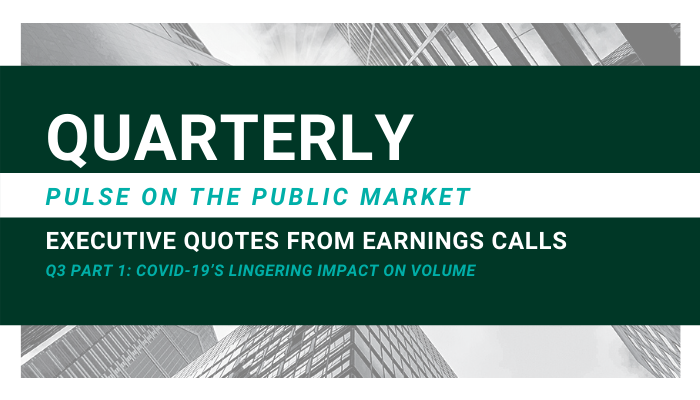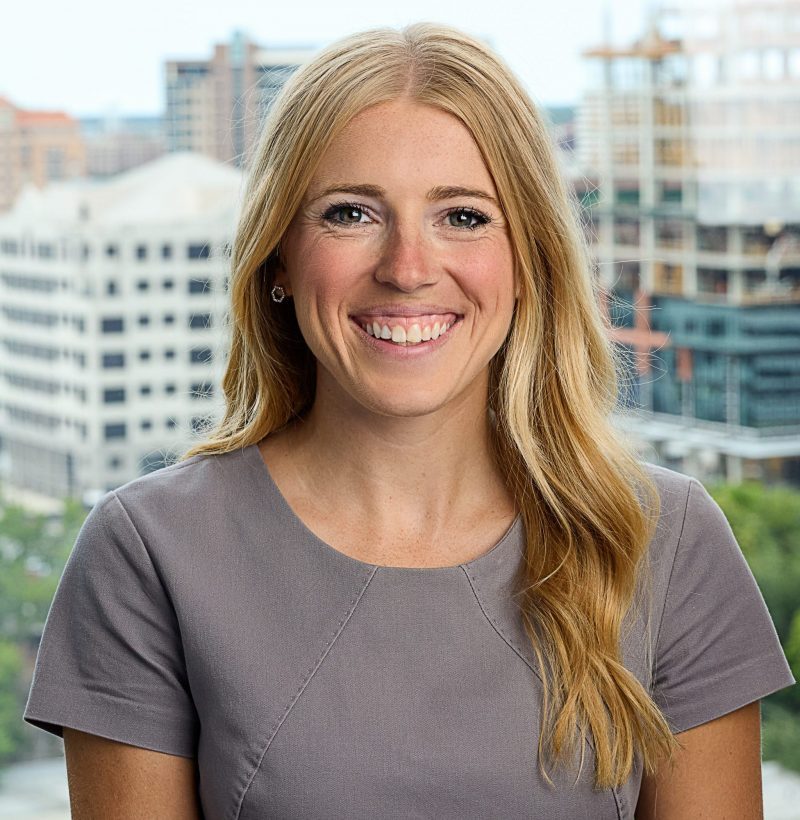
Contributors: Savanna Dinkel, Blake Madden and Keith Ponsler
As the healthcare sector continues to operate affected by the coronavirus (“COVID-19”) pandemic, insights and experiences from the provider sector are particularly interesting.
In a three-part series over the coming weeks, VMG will summarize key observations and common themes from public healthcare firms on the following topics:
- Part 1: COVID-19’s lingering impact on payor and provider volumes;
- Part 2: expense management and cost savings; and
- Part 3: understanding the impact to the mergers and acquisitions market.
Part 1: COVID-19’s Lingering Impact on Volume
Payors: Continued Return of Medical Costs in the second half of 2020
With decreased patient demand for healthcare services in Q1 2020 and historically low medical cost ratios in Q2 2020, payors’ earnings were significantly higher in the first half of the year due to temporary care deferrals. Patients who missed treatments during the first half of the year continued to return to the healthcare system during Q3, and payors, such as UnitedHealthcare, experienced lingering effects from the pandemic due to ongoing disruptive patient patterns:
“Broadly speaking, third-quarter results continued to be impacted by disruptive care pattern, albeit to a much lesser extent than in the second quarter as many regions of the country stabilized nearer to more normalized level. Within the quarter, care deferral impacts were more than offset by the proactive consumer and customer assistance measures we voluntarily undertook earlier this year as well as COVID-19 care and testing costs and broader economic effects. These factors resulted in a 10% year-over-year decline in adjusted earnings per share.”
John F. Rex, Executive VP & CFO, UnitedHealthcare Q3 2020 Earnings Call Transcript
Providers: Volumes Continue to Recover
During Q3, COVID-19 restrictions lifted significantly, and healthcare activity trended toward a return to normalcy. Providers were still faced with an array of challenges as they continued to adjust to shifts in operations and protocols to accommodate a continuously changing COVID-19 world.
In Q3, providers benefited from a return of elective surgeries as backlogs for outpatient surgeries continued to grow. In addition to the steady demand, providers consistently noted the severe initial disruption within the patient referral and admission patterns seen in the second quarter has noticeably dissipated throughout the third quarter.
Finally, as COVID-19 cases appeared to stabilize during Q3, providers are cautiously optimistic about continued volume growth in light of another surge in COVID-19 cases among certain markets.
Hospitals
“On June recovery, by the way, certainly benefited from a great deal of pent-up demand. We were very focused on getting that business in the door. And we did see some shifting or deferrals in July into August. But as the COVID surge subsided and as we expected, we saw more elective cases come back into the hospital … In terms of heading into October, September was a good month. Heading into October, we’re pleased with the further progression of our volume recovery. We are, as we pointed out today, seeing some resurgence of COVID and haven’t necessarily seen any requirements for shutdowns or curtailing elective services that we’re monitoring on a day-by-day basis.”
Tim L. Hingtgen, President, COO & Director, Community Health Systems Q3 2020 Earnings Call Transcript
“Despite the COVID-19 case surge, which was about 60%-plus in late July and August compared to the second quarter across our system, we delivered a solid performance in every part of our business. While we experienced a surge, we safely handled caring for COVID and non-COVID patients.”
“In the hospitals, volumes for the quarter ended close to 90% at pre-COVID levels. This is continuing to be a solid recovery during the time period and remains very positive. Our operators across our markets have responded very well given the nature of the complexities of the pandemic, and we continue to perform tightly aligned to the volumes presented.”
Ronald A. Rittenmeyer, Executive Chairman & CEO, Tenet Healthcare Q3 2020 Earnings Call Transcript
Post-Acute Care
“While total discharges were down 1.5% compared to the third quarter of 2019, this number improved significantly from the 10.7% decrease in volumes we experienced in the second quarter of 2020. The remaining lag to returning to prior year volumes primarily is related to orthopedic and lower extremity joint replacement cases. Many of our markets continue to have limited elective surgeries, particularly with elderly patients with complex medical conditions. These patients are the ones that tend to need inpatient rehabilitative services post-surgery… We also continue to experience COVID-related challenges in certain geographic markets, specifically Florida, where we have 12 inpatient rehabilitation hospitals. We experienced a 12.8% year-over-year decline in patient discharges in Florida in the third quarter of 2020.”
“Factors that have impacted our volumes include the number of COVID-19 cases in a community, the status of operations at acute care hospitals, the number of exposed or positive staff in quarantine, delays in obtaining COVID-19 test results for patients and employees and capacity limitations created by semi-private rooms in some of our hospitals. While COVID patients do not comprise a large percentage of our patients, many of our hospitals, home health agencies and hospice agencies treat patients recovering from the virus. These patients, many of whom have spent time on ventilators, had endured extended stays at an acute care hospital. They are extremely weak and require intense rehabilitation to regain both their strength and cognitive abilities.”
Mark Tarr, Executive VP & CEO, Encompass Health Corporation Q3 2020 Earnings Call Transcript
“In home health admissions, we are close to where we were pre-COVID. And in hospice, we are in line with pre-COVID levels already … sequentially, we are up 13.1% in home health same-store admissions in Q3 from Q2. And in hospice, we’re up 8.3%.”
Joshua L. Proffitt, President, LHC Group Q3 2020 Earnings Call Transcript
Imaging
“First of all, I think it should be understood that [while] volumes even have come back substantially to the pre-COVID levels, I believe that there will be a number of people who still remain reluctant to come out for visitation to access not just health care, and I believe that will stay that way for probably well into 2021.”
“Somewhere in the mix there, I think you put it into the factors like Cigna and other health insurers are continuing to make major strides or efforts to directing people away from hospitals. And people themselves perhaps now look at outpatient ancillary services, particularly imaging in a little bit more of a rational way, given the fact that they were not to have to go into the environment of a hospital. I think all of those factors have weighed in and will continue to improve for us, particularly going to be a better half in the coming months.”
Howard G. Berger, Chairman, President, CEO & Treasurer, RadNet Q3 2020 Earnings Call Transcript
Outpatient Care
“Our same-facility volumes for the quarter averaged 97% of the prior year, and in the month of September, we achieved 99% of prior year volumes, our best results since the beginning of the pandemic. We continue to see higher acuity cases, such as orthopedic and spine surgeries, exceeding prior year levels, while the recovery of lower acuity cases, such as GI, continue to slightly lag, with results in the low 90s percentile of prior year volume for the quarter.”
Eric Evans, CEO & Director, Surgery Partners Q3 2020 Earnings Call Transcript
“With respect to volume, given the unusual volatility we have seen in 2020 with COVID-19 surges, mandatory and voluntary suspension of elective business and intermittent recovery periods, we currently plan to use 2019 volumes as a starting reference point for early 2021 planning purposes.”
Samuel N. Hazen, CEO & Director, HCA Healthcare Q3 2020 Earnings Call Transcript
Behavioral Health
“Overall, in the acute area, we saw a very robust volume, and it’s far exceeding where we were last year, and certainly, pre-COVID…. we’ve continued to see improvement in the census in both the U.S. and the U.K., and I think we actually hit the highest census in the history of Acadia in October.”
“For our specialty service line, we were pleased to see stabilization in our volumes. By shifting our marketing strategies to focus on local and regional markets, we were able to reach those that need the very specialized services that we provide. During the quarter, we also saw a sequential improvement in our out-of-state referrals due to patients being more willing to travel. However, we’ve not yet seen our referrals return to prior year levels.”
Debra K. Osteen, CEO & Director, Acadia Healthcare Company Q3 Earnings Call Transcript
Real Estate
“Our hospitals are all back to essentially normal operations. They range from low 90s to over 100% of where they were in 2019. When COVID first hit, hospital operators across our portfolio did a fantastic job of cutting expenses and streamlining operations. All of our operators have strong liquidity positions and all are looking forward to new opportunities. As predicted, the backlog of nonemergency surgeries has pushed surgical volumes back to pre-COVID-19 levels at many of our hospitals and some even ahead of budgeted and prior year numbers. For instance, our hospitals in Spain have seen an increase in outpatient and surgical volumes as the backlog at the public hospitals has forced them to redirect patients to our private hospitals. This has created a fortuitous opportunity for our Spanish operators as these patients experience firsthand, the top-notch facilities and care provided at these private hospitals.”
Edward K. Aldag, Founder, Chairman, President & CEO, Medical Properties Trust, Inc. Q3 2020 Earnings Call Transcript
The Road Back to Normalcy
Operators saw much improvement in Q3 from a quarter impacted by the month-long shutdown in April. Many executives noted strong volume trends by September and were encouraged by early October results. Providers remain cautiously optimistic about a continued ramp-up in volume as long as COVID-19 diagnoses remain stable. Due to the continued uncertainty, the sector is still not providing fiscal year 2021 guidance, but hopes these positive volume trends will remain intact as healthcare continues to battle the pandemic and move forward on the road back to normalcy.





